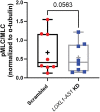Lysyl oxidase-like 1-antisense 1 (LOXL1-AS1) lncRNA differentially regulates gene and protein expression, signaling and morphology of human ocular cells
- PMID: 37540217
- PMCID: PMC10586201
- DOI: 10.1093/hmg/ddad128
Lysyl oxidase-like 1-antisense 1 (LOXL1-AS1) lncRNA differentially regulates gene and protein expression, signaling and morphology of human ocular cells
Abstract
Pseudoexfoliation glaucoma (PEXG) is characterized by dysregulated extracellular matrix (ECM) homeostasis that disrupts conventional outflow function and increases intraocular pressure (IOP). Prolonged IOP elevation results in optic nerve head damage and vision loss. Uniquely, PEXG is a form of open angle glaucoma that has variable penetrance, is difficult to treat and does not respond well to common IOP-lowering pharmaceuticals. Therefore, understanding modulators of disease severity will aid in targeted therapies for PEXG. Genome-wide association studies have identified polymorphisms in the long non-coding RNA lysyl oxidase-like 1-antisense 1 (LOXL1-AS1) as a risk factor for PEXG. Risk alleles, oxidative stress and mechanical stretch all alter LOXL1-AS1 expression. As a long non-coding RNA, LOXL1-AS1 binds hnRNPL and regulates global gene expression. In this study, we focus on the role of LOXL1-AS1 in the ocular cells (trabecular meshwork and Schlemm's canal) that regulate IOP. We show that selective knockdown of LOXL1-AS1 leads to cell-type-specific changes in gene expression, ECM homeostasis, signaling and morphology. These results implicate LOXL1-AS1 as a modulator of cellular homeostasis, altering cell contractility and ECM turnover, both of which are well-known contributors to PEXG. These findings support LOXL1-AS1 as a key target for modifying the disease.
© The Author(s) 2023. Published by Oxford University Press. All rights reserved. For Permissions, please email: journals.permissions@oup.com.
Figures





References
-
- Aboobakar, I.F., Johnson, W.M., Stamer, W.D., Hauser, M.A. and Allingham, R.R. (2017) Major review, exfoliation syndrome, advances in disease genetics, molecular biology, and epidemiology. Exp. Eye Res., 154, 88–103. - PubMed
-
- Johnson, W.M., Finnegan, L.K., Hauser, M.A. and Stamer, W.D. (2018) lncRNAs, DNA methylation, and the pathobiology of exfoliation glaucoma. J. Glaucoma, 27, 202–209. - PubMed
-
- Schlotzer-Schrehardt, U. (2009) Molecular pathology of pseudoexfoliation syndrome/glaucoma – new insights from LOXL1 gene associations. Exp. Eye Res., 88, 776–785. - PubMed
-
- Ou, Y. (2021) Pseudoexfoliation (PEX) syndrome and Pseudoexfoliation glaucoma. BrightFocus Foundation, in press.
-
- Lee, D.A. and Higginbotham, E.J. (2005) Glaucoma and its treatment: a review. Am. J. Health Syst. Pharm., 62, 691–699. - PubMed
Publication types
MeSH terms
Substances
Grants and funding
LinkOut - more resources
Full Text Sources
Research Materials

